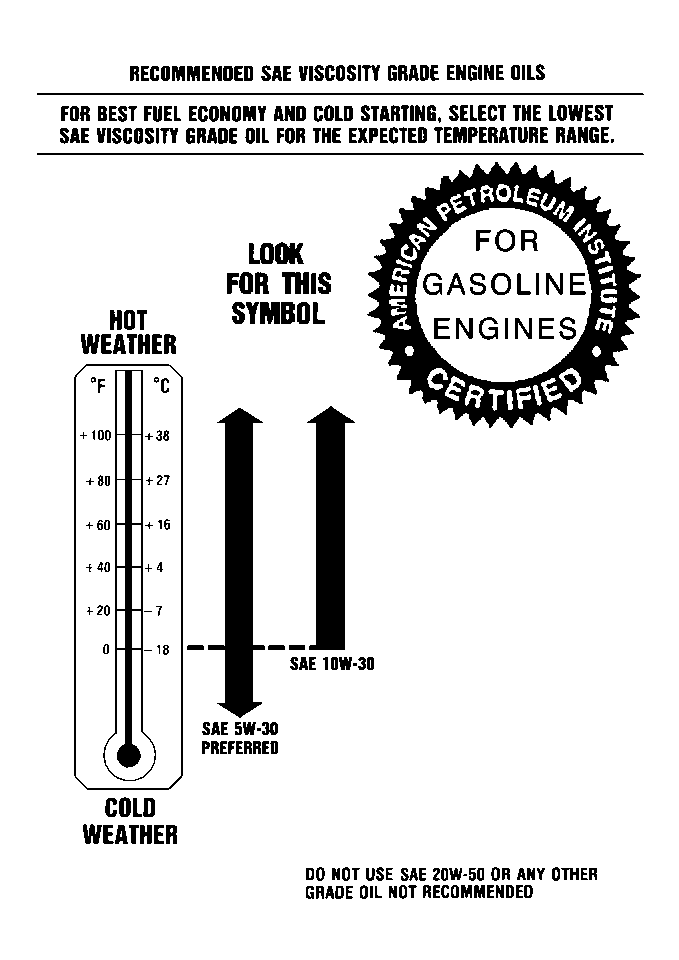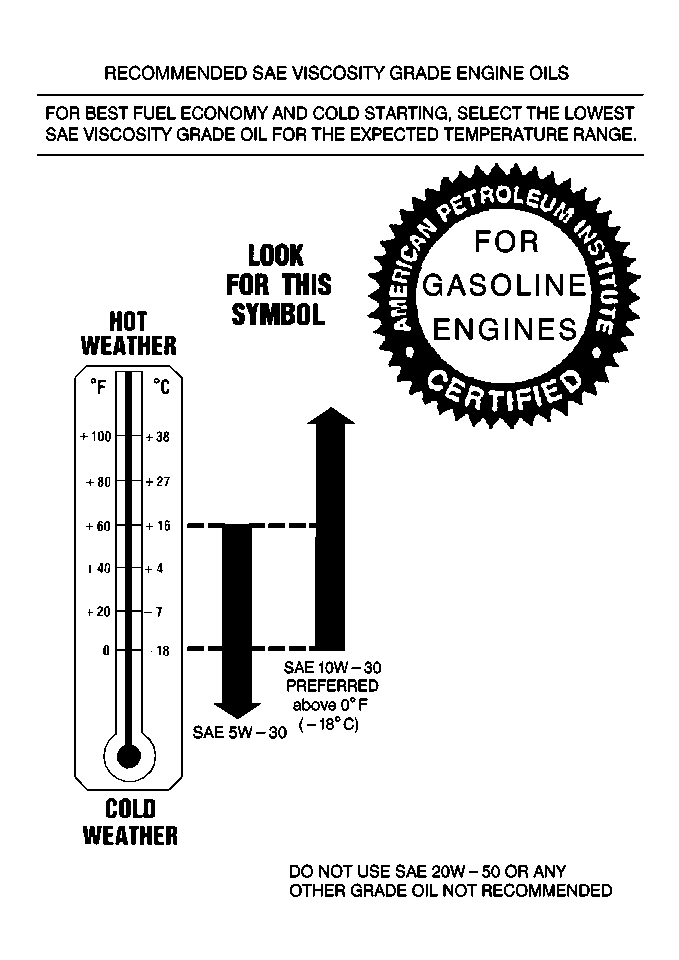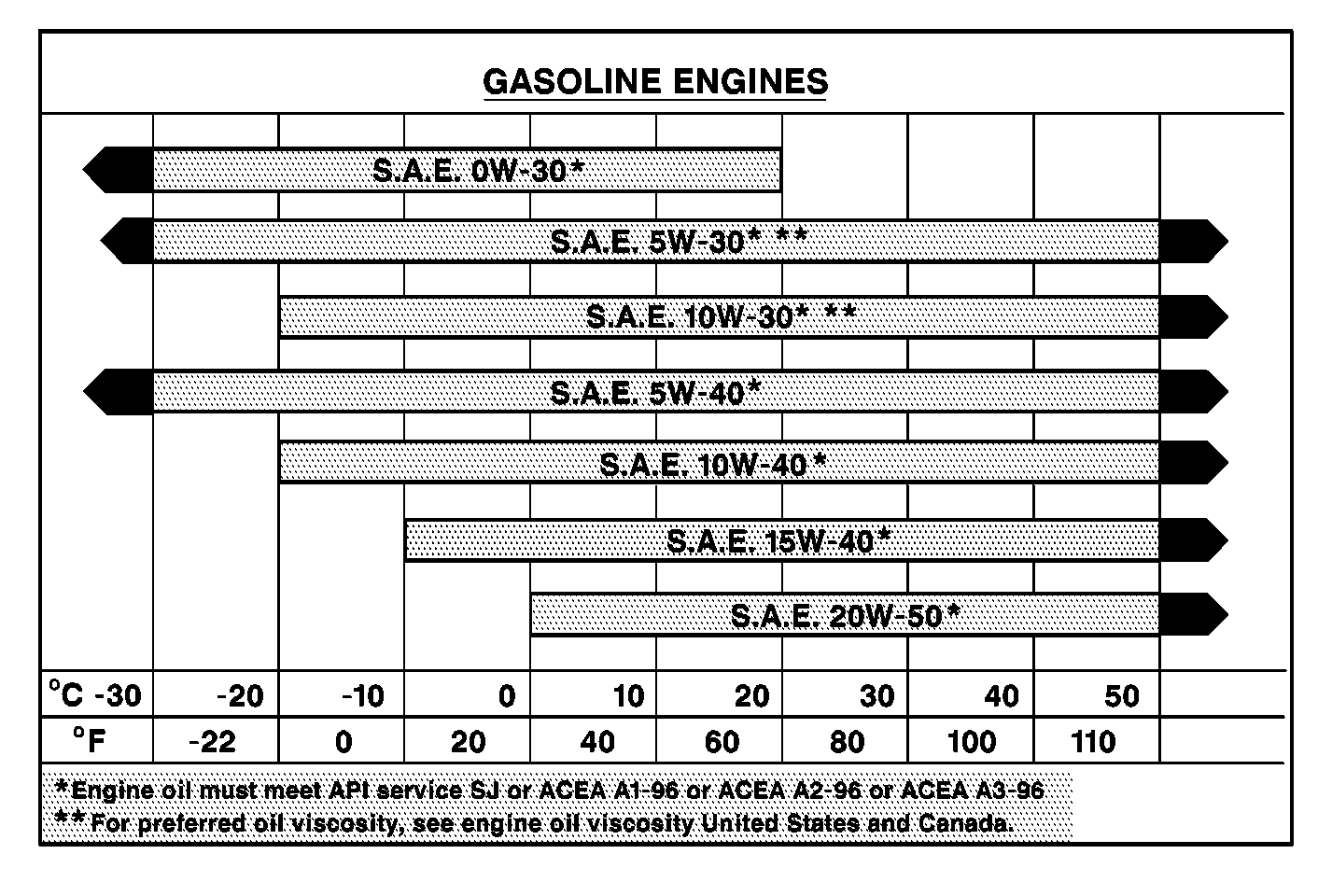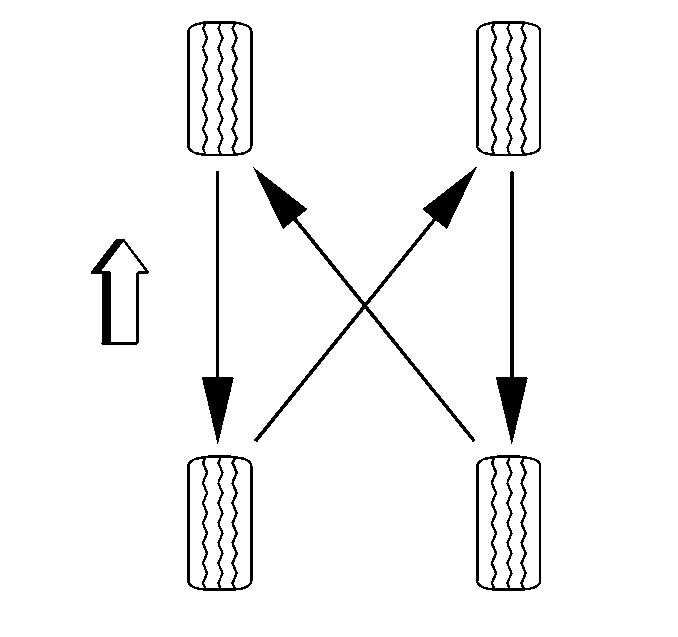For time and/or mileage intervals of scheduled maintenance items, refer to Maintenance Schedule .
The following text and illustrations describe the details of the required scheduled maintenance services.
For information on the proper fluids and lubricants to use, refer to Fluid and Lubricant Recommendations .
Engine Oil and Oil Filter Change
Replace the engine oil and the engine oil filter.
| • | For the 3.1 engine, refer to Engine Oil and Oil Filter Replacement in Engine Mechanica-3.1L. |
| • | For the 3.8 engine, refer to Engine Oil and Oil Filter Replacement in Engine Mechanical-3.8L. |
Engine Oil Quality United States and Canada
Oils of the proper quality for the vehicle can be identified by looking for the STARBURST symbol. The STARBURST symbol indicates that the oil has been certified by the American Petroleum Institute (API), and is preferred for use in gasoline engines.
Engine Oil Viscosity
Engine oil viscosity (thickness) has an effect on the fuel economy and the cold-weather operation (engine starting and oil flow). Lower viscosity engine oils can provide better fuel economy and cold-weather performance. However, higher temperature weather condition require higher viscosity engine oils for satisfactory lubrication.
Notice: Using oils of any viscosity other than those recommended could result in engine damage. When choosing an oil, consider the range of temperatures the vehicle will be operated in before the next oil change. Then, select the recommended oil viscosity.
Important: If the vehicle is operated in an area where the temperature falls below -29°C (-20°F), consider using a SAE 5W-30 synthetic oil or a SAE 5W-30 oil. Both will provide easier cold starting and better protection for the vehicle's engine at extremely low temperatures.
Oil Viscosity Recommendation for 3100 L82 (VIN M)

| • | For the 3100 L82 (VIN M) engine,SAE 5W30 is the recommended viscosity. However, if the outside air temperature is above -18°C (0°F) 10W-30 may be used. Do not use other viscosity oils, such as SAE 20W-50. |
Oil Viscosity Recommendation for 3800 L36 and 3800 L67

| • | For the 3800 L36 (VIN K) or the 3800 L67 (VIN 1) engine, SAE 10W-30 is the recommended viscosity. However, if the outside air temperature is colder than 16°C (60°F) 5W-30 may be used. Do not use other viscosity oils, such as SAE 20W-50. |
Engine Oil Quality and Viscosity, (Other Than The United States and Canada)

Notice: Using oils of any viscosity other than those recommended could result in engine damage. When choosing an oil, consider the range of temperatures the vehicle will be operated in before the next oil change. Then, select the recommended oil viscosity.
Tire and Wheel Inspection and Rotation

Rotate the tires to equalize the wear and obtain maximum tire life. Refer to Tire Rotation
Check the tires for abnormal wear or damage. If irregular or premature tire wear exists, refer to Tire Diagnosis - Irregular or Premature Wear in Suspension General Diagnosis.
Brake System Inspection
Inspect brake lines and hoses for proper hook-up binding, leaks, cracks or chafing. Refer to Brake Hose Inspection in Hydraulic Brakes. Inspect disc brake pads for wear. Refer to Brake Pad Inspection in Disc Brakes. Inspect the rotors for poor surface condition. Inspect other brake system components, including the brake calipers and the parking brake. Check the parking brake adjustment. The brakes may need to be inspected more often if the customer's driving habits or conditions result in frequent braking.
Air Cleaner Filter Inspection and Replacement
Replace the air cleaner filter according to the maintenance schedule intervals.
For maintenance schedule information, refer to Maintenance Schedule .
For air cleaner filter replacement procedure, refer to Air Filter Element Replacement for 3.1 L Engine Controls or Air Cleaner Element Replacement for 3.8 L Engine Controls.
Supercharger Oil Level Inspection
Inspect the supercharger oil level and add oil if necessary. Refer to Supercharger Oil Level Inspection
Automatic Transaxle Service
Change the transmission fluid and the transmission fluid filter.
Refer to Automatic Transmission Fluid Filter and Seal Replacement in Transmission/Transaxle-4T60-E.
Refer to Automatic Transmission Fluid Filter and Seal Replacement in Transmission/Transaxle-4T65-E.
Drive Belt Inspection
Inspect the drive belt according to the maintenance schedule intervals.
For time and/or mileage intervals of scheduled maintenance items, refer to Maintenance Schedule .
Inspect the drive belt for the following:
| • | Cracks |
| • | Fraying |
| • | Wear |
| • | Proper tension |
| • | If the vehicle has a 3.1 L engine, refer to Drive Belt Excessive Wear Diagnosis in Engine Mechanical. |
| • | If the vehicle has a 3.8 L engine, refer to Drive Belt Excessive Wear Diagnosis in Engine Mechanical. |
Fuel Tanks, Cap and Lines Inspection
Periodic replacement of the fuel filter is not required.
Inspect the following components for damage or leaks:
| • | Fuel tank |
| • | Fuel tank cap |
| Inspect the fuel tank cap seal for an uneven filler neck imprint and any damage. |
| • | Fuel lines |
| • | Fuel rail |
| • | Fuel injectors |
For fuel system diagnosis information, refer to Fuel System Diagnosis in Engine Controls-3.8 L.
For fuel system diagnosis information, refer to Fuel System Diagnosis in Engine Controls-3.1 L.
Cooling System Service
Drain, flush and refill the cooling system with new coolant. Refer to Cooling System Draining and Filling in Engine Cooling.
For time and/or mileage intervals of scheduled maintenance items, refer to Maintenance Schedule .
Spark Plug Wire Inspection
Clean the spark plug wires and inspect for burns, cracks or other damage. Ensure that the fit between the spark plug wire boots at the spark plugs and at the coils is snug. Replace the spark plug wires as needed.
| • | If the vehicle has a 3.1 L engine, refer to Spark Plug Wire Harness Replacement in Engine Electrical. |
| • | If the vehicle has a 3.8 L engine, refer to Spark Plug Wire Harness Replacement in Engine Electrical. |
Spark Plug Replacement
Replace the spark plugs according to the maintenance schedule intervals.
For time and/or mileage intervals of scheduled maintenance items, refer to Maintenance Schedule .
For information on the correct type of spark plug, refer to Maintenance Items .
| • | If the vehicle has a 3.1 L engine, refer to 1 Spark Plug Replacement in Engine Electrical. |
| • | If the vehicle has a 3.8 L engine, refer to Spark Plug Replacement in Engine Electrical. |
